How To Get
IT Service Managment with DevTools
ITSM Experts
What is ITSM?
IT service management— often referred to as ITSM— is simply how IT teams manage the end-to-end delivery of IT services to customers. This includes all the processes and activities to design, create, deliver, and support IT services. ITSM teams oversee all kinds of workplace technology, ranging from laptops, to servers, to business-critical software applications.
IT Service Managment Process
Bring your development and IT operations teams together to rapidly respond to, resolve, and continuously learn from incidents.
Incident management
Bring your development and IT operations teams together to rapidly respond to, resolve, and continuously learn from incidents.
Problem management
Group incidents to problems, fast-track root cause analysis, and record workarounds to minimize the impact of incidents.
Change and release management
Empower your IT operations teams with richer contextual information around changes from software development tools so they can make better decisions and minimize risk.
Knowledge Management
Leverage Confluence for an open approach to knowledge management. Foster team collaboration across ITSM practices.

Request management
Manage work across teams with one platform so your employees and customers quickly get the help they need.
Configuration management
Gain visibility into the infrastructure that supports applications and services. Anticipate the downstream impact of changes, so your dev and ops teams can manage risk and rapidly resolve incidents when they do occur.
Enterprise Service Management
Enterprise Service Management (ESM) – often referred to as ESM, is the extension of IT Service Management (ITSM) principles to enable better service delivery for business teams like Human Resources (HR), legal, facilities, marketing, and finance. ITSM is how IT teams manage the end-to-end delivery of IT services to customers
Service Request Management
Service request management is a repeatable procedure for handling the wide variety of customer service requests, like requests for access to applications, software enhancements, and hardware updates. The service request workstream often involves recurring requests, and benefits greatly from enabling customers with knowledge and automating certain tasks.
Asset Management
Unlike legacy CMDBs, a flexible and open data structure allows teams to manage any asset. Efficiently track ownership and lifecycles, and reduce costs.
ITSM Service with Devtools
Devtools can help you to prepare for the future of ITSM with automation tools to support every aspect implementation, delivery and management.
Contact ITSM ExpertsAspect Implementation
IT service management (ITSM) is a set of policies and practices for implementing, delivering and managing IT services for end users in a way that meets the stated
Delivery and Management
IT service management (ITSM) is a set of policies and practices for implementing, delivering and managing IT services for end users in a way that meets the stated
IT Service Management Benefits
The goal of ITSM is to ensure that IT services perform in a way that meets the needs of the users and the business.
Aligning IT teams with business priorities tracked through success metrics
Enabling cross-department collaboration
Bringing IT teams and development teams together through streamlined project management approaches
Empowering IT teams to share knowledge and continuously improve
Improving request coordination for more efficient service
Promoting customer-centricity with self-service and better processes
Responding more quickly to major incidents, and preventing future ones
All of which decrease costs and lead to better service.
ITSM software and tools
ITSM software enables IT teams to align with business needs and take a strategic approach to organizational change, transformation, and growth. There are a wide variety of ITSM software tools available in the market, from standalone applications to platform services.
We often hear IT teams complain that the traditional ITSM tools they use are inflexible, and consequently difficult to customize and adapt to evolving requirements. There also tend to be different tools for the various ITSM processes. Modular tools create barriers, silo people, and promulgate a lack of visibility across teams. Traditional ITSM tools are often difficult to deploy and manage, and end users avoid adopting tools that aren’t intuitive, which also leads to deficient or non-existent self-service ITSM capabilities.
Choosing the right service desk software for your organization is critical, as the service desk is a foundation of ITSM. The service desk will be the interface between customers and the IT team. ITIL defines a service desk as "the single point of contact between the service provider and the users. A typical service desk manages incidents and service requests, and also handles communication with the users." The service desk should also play an important role in managing other ITSM processes. Consider whether your service desk and other ITSM tools meet the following requirements:
Easy to use and setup
Comes with a clean, intuitive self-service portal that makes it easy to request help, search knowledge, and track progress on issues.
Enables collaboration
Provides a platform for developers and cross-functional teams to work together for faster issue resolution.
Adapts to your needs
Is flexible enough to support any resolution, escalation, or change process your IT Teams might dream up.
